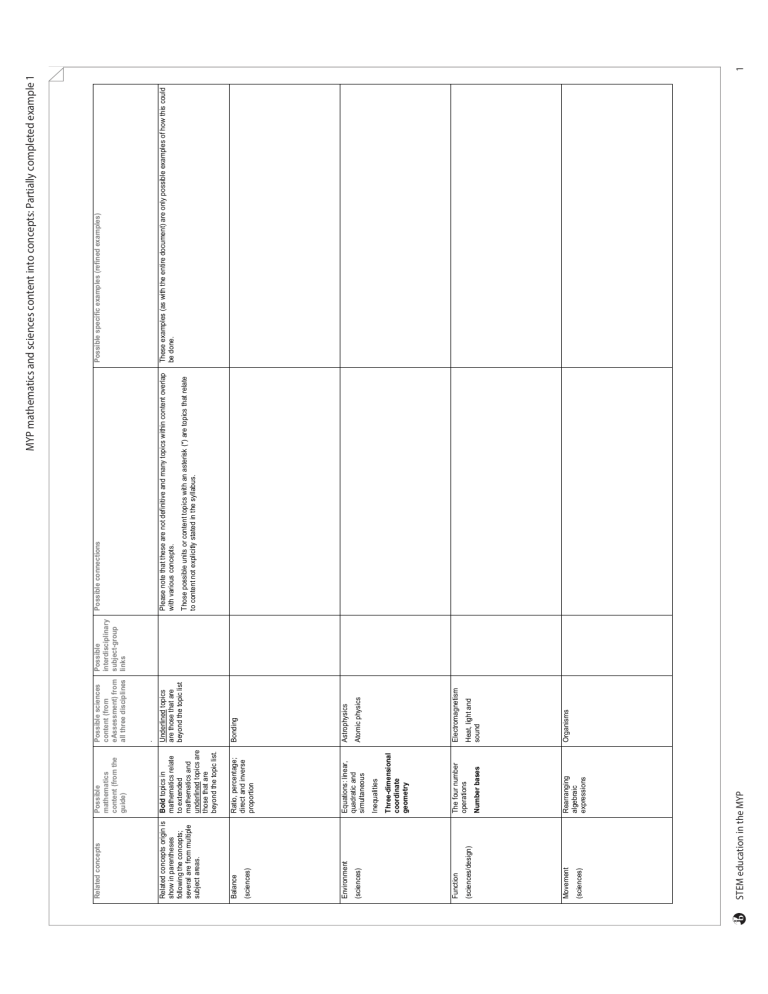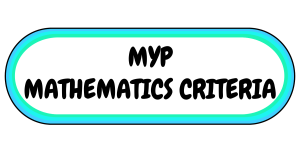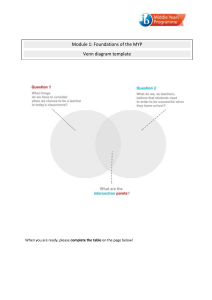
Ratio, percentage; direct and inverse proportion Balance Rearranging algebraic expressions Number bases The four number operations Three-dimensional coordinate geometry Inequalities STEM education in the MYP (sciences) Movement (sciences/design) Function (sciences) Environment Equations: linear, quadratic and simultaneous Bold topics in mathematics relate to extended mathematics and underlined topics are those that are beyond the topic list. Related concepts origin is show in parentheses following the concepts; several are from multiple subject areas. (sciences) Possible mathematics content (from the guide) Related concepts Organisms Heat, light and sound Electromagnetism Atomic physics Astrophysics Bonding Underlined topics are those that are beyond the topic list . Possible sciences content (from eAssessment) from all three disciplines Possible interdisciplinary subject-group links Those possible units or content topics with an asterisk (*) are topics that relate to content not explicitly stated in the syllabus. Please note that these are not definitive and many topics within content overlap with various concepts. Possible connections These examples (as with the entire document) are only possible examples of how this could be done. Possible specific examples (refined examples) MYP mathematics and sciences content into concepts: Partially completed example 1 1 Inequalities (sciences) Prime numbers and factors Evidence STEM education in the MYP The unit circle Algorithms Patterns and sequences Patterns Evolution The periodic table Astrophysics Sine and cosine rules (mathematics/sciences) Forces and energy Algebraic fractions (sciences) Processes Processes Interactions with environment Atomic physics Organisms Interaction Standard deviation Triangle properties (sciences) (sciences) Angle properties Consequences Sine and cosine rules Circle geometry Venn diagrams Conditions MYP mathematics and sciences content into concepts: Partially completed example 1 2 Similarity and congruence STEM education in the MYP Trigonometric identities Substitution (mathematics) Simple transformations, including isometric transformations Ratio, percentage; direct and inverse proportional Vectors and vector spaces Equivalence (sciences) Transformation Processes Interactions with environment Evolution Logarithms Logarithms with different base numbers Waves Forms of numbers Matter Organisms Metabolism Interactions between organisms (mathematics/sciences) Measures of central tendency/location Addition, subtraction, multiplication and division of algebraic terms Models (sciences) Energy (sciences) Transfer MYP mathematics and sciences content into concepts: Partially completed example 1 3 Sets Units of measurement Justification (mathematics) Number systems STEM education in the MYP Graphical analysis and representation Integer and fractional exponents Number lines Forms of numbers (mathematics) Angle measures Integer exponents Units of measurement Distance Integer and fractional exponents Conditional probability Representation (mathematics) Quantity (mathematics) Measurement Trigonometric ratios in right-angled triangles (mathematics) Substitution Forms of numbers Generalization Waves IUPAC naming Atomic physics Matter The periodic table Types of chemical reaction Evolution MYP mathematics and sciences content into concepts: Partially completed example 1 4 Trigonometric identities Number lines Logarithms (mathematics) Space (mathematics) Units of measurement Measures of central tendency/location Collaboration Ergonomics STEM education in the MYP (design) Measures of dispersion Probability of an events or trials (design) (design) Algebraic fractions Adaptation Sine, cosine, logarithmic, rational, inverse and composite functions Estimation Simplification Biotechnology Atomic physics Organisms The atmosphere Waves MYP mathematics and sciences content into concepts: Partially completed example 1 5 Arithmetic and geometric series (design) Patterns and sequences (design) Distance (design) STEM education in the MYP Perimeter/area/ volume Number systems Perspective Processes Interactions between organisms Number sequences Markets and trends (design) Conditional probability Human interactions with environments Invention (design) Types of chemical reactions Human interactions with environments Innovation The cartesian plane Geometrical elements and their classification Algorithms Evaluation MYP mathematics and sciences content into concepts: Partially completed example 1 6 Population sampling Estimation STEM education in the MYP (design) Sustainability (design) Resources Matter Pure and impure substances MYP mathematics and sciences content into concepts: Partially completed example 1 7



